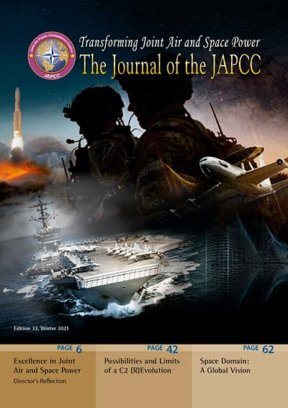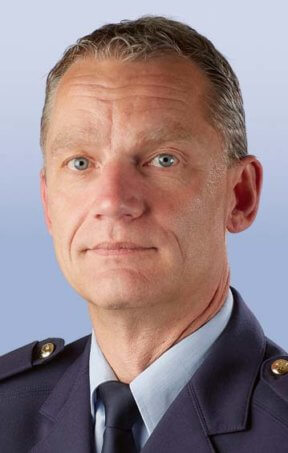Introduction
The world is changing rapidly. The geopolitical landscape is transforming as a result of the strategic competition among existing, emerging, and revisionist powers. Simultaneously, these powers are developing emerging technologies, such as artificial intelligence, quantum computing, and hypersonic missiles at an incredibly rapid pace. Our societies are more connected through our smartphones, smart homes, and the internet of things. The growing world population is struggling to comprehend and overcome the challenges of climate change and global pandemics, resulting in an economy under pressure from both events. These trends and developments impact our armed forces in their efforts to stay relevant in safeguarding peace and security and making the necessary changes to organizations, capabilities, and operational concepts.
In this volatile, uncertain, complex, and ambiguous context, the Royal Netherlands Air Force (RNLAF) is transforming into a 5th Generation Air Force. Since we launched our ‘5th Generation Air Force’ vision in 2017, the RNLAF has incorporated a number of new weapon systems: our new Chinook F/CAAS-helicopters, the multinational A330 MRTT, the MQ-9 Reaper, and the F-35 Lightning II. Perhaps less visible, but certainly not less important, we have been transforming our organization, including how we train and exercise, to prepare for Joint All-Domain Operations (JADO). Finally, we have put information, data science, and software at the core of our efforts to improve our processes to fly, fight, and win more effectively and more safely. This article will highlight some of our ‘lighthouse projects’1 to illustrate the challenges we had to overcome and the solutions we were able to find. It will first look at the new possibilities that 5th generation capabilities offer, particularly sensors and connectivity. Next, it will explain innovative ways of implementing the required changes. Finally, the article will provide an insight into some of the innovative and transformative units that are leading the way toward operationalizing our ‘5th Generation Air Force’ vision: the Data Science Cell, the Space Security Centre, the Cyber Warfare Team and the F-35 Operational Test and Evaluation (OT&E) Unit. The article will conclude by drawing conclusions and providing some key takeaways.
New Capabilities Supporting the Joint All-Domain Fight
The 5th generation capabilities are mainly about employing ‘next-level’ weapons systems to speed up our effects-cycle so we ‘outpace’ and ‘outsmart’ an opponent. It is also about keeping the technological edge over potential adversaries. Leading-edge technologies are applied to combine sensors with kinetic and non-kinetic effectors resulting in improved connectivity and survivability. The F-35 is clearly the centrepiece of our 5th generation air combat capability, but other new weapon systems like the MQ-9 and our new AH-64E are also part of the bedrock that underpins a next-level Air Force. The F-35 combines low observability with a sensor suite that is unmatched by any 4th generation fighter aircraft. On top of that, stand-off capabilities enable us to exploit altitude, speed, and range to our advantage. Furthermore, the F-35 brings new maintenance and logistics concepts to maximize mission availability. Clearly, 5th generation capabilities bring to bear the ability to operate near and through Anti-Access/Area Denial (A2/AD) regions that some of the revisionist powers tend to deploy. As advanced as the aircraft and its systems may be, to prevail in tomorrow’s combat missions, the main aim is to overwhelm potential adversaries with challenges and to get inside their Observe-Orient-Decide-Act (OODA) loop. Information dominance enables decision dominance, which is required to deter, defend, and dominate in modern combat. This means that data and information handling are becoming more critical in support of airpower. It is my firm belief that in the upcoming decade software will become as important, if not more important, than hardware. 5th generation capabilities are synonymous with information, are data-driven by design, and are potentially capable of functioning as nodes in a combat cloud. However, that will only happen if we unlock and find ways to share data and information more seamlessly than we are able to do now. As a coalition, we still have some steps to go to make this happen.
Innovate by Doing!
Receiving 5th generation capabilities stresses the importance of what we call an ‘operational information backbone’. This federated combat network with layered security connects participants in multiple domains and enables joint all-domain command and control. During the first few years of our transformation, we found that building and experimenting with small parts of this network is more important than first designing (and debating) an overall solution. Modus operandi from the digital industry assisted us in digitizing the battlespace and improving our adaptability to rapidly changing threat conditions. The use of Artificial Intelligence (AI) and Robotic Process Automation (RPA) freed up scarce resources (i.e. personnel), particularly in processes that comprise dirty, dull, or dangerous tasks. The newly available resources are necessary to continue to perform operational tasks that require meaningful human control. Therefore, future combat units will have to be resourced with cyber experts, data scientists, and AI-specialists that continuously support the unit in improving its combat effectiveness. These changes cannot happen overnight, but they can begin in small start-up formats at the edges of our organization and in close cooperation with civil partners. These projects are designed to either fail fast or be scaled-up, if successful. It was merely the combination of the inherently pioneering spirit of our Airmen and the cooperation with digital partners that enabled us to stand-up and scale-up the following 5th generation lighthouse units. However, we need to be realistic about the tempo we can achieve in scaling our innovative efforts. Most of our Air Forces are facing limited budgets which, combined with the limited personnel resources we can dedicate to the innovation of all our other tasks, drives the tempo of our common innovation agendas.
The RNLAF’s Lighthouse Units
The Data Science Cell (DSC)
The DSC delivers data-driven, decision-making support products to accelerate and strengthen our transition to the 5th Generation RNLAF. The DSC started in 2017 and groups together a small number of military and civil data science experts. Firstly, the DSC tested and experimented with big data analysis to prove its added value for the RNLAF. This first phase concluded in less than a year and the RNLAF decided to take DSC to the next level and connect it to the operational and maintenance processes. Today the DSC is working on applications in the fields of predictive flight maintenance planning, long-term readiness planning, human resources analytics, and analysis of imagery from the sensors of 5th generation systems.
The Defence Space Security Center (DSSC)
In response to developments in the geopolitical arena and the lower threshold of access to space capabilities, the RNLAF has started to develop knowledge in the military use of space with the aid of the DSSC. After building capacity for monitoring space weather and developing space situational awareness, we recently launched a small communication satellite named ‘BRIK II’. This project was conducted in close cooperation with the Dutch small satellite or SmallSat enterprise and the Royal Aerospace Laboratory (NLR). The launch was contracted to Virgin Orbit, which gave us an opportunity to experiment with Responsive Launch Capability. Furthermore, the dual-use nature of space capabilities offers exciting opportunities to cooperate among European militaries and industries with the aim of improving Europe’s strategic autonomy in space. Even though the Ministry of Defence has not yet issued a formal space policy, the RNLAF is ready to scale up its efforts to develop a national military use of space capability in order to safeguard national and European interests in this new domain. Obviously, we are also building this capability on the foundation of our transatlantic partnership. This is illustrated by our participation in the Responsive Space Capability programme, among other projects.
Cyber Warfare Team
Geopolitical developments have led to strategic competition in cyberspace. Hyper-connected societies have become more vulnerable to threats in the virtual and cognitive domains. Cyber security has become an essential part of any company’s or organization’s efforts to mitigate the risks of cybercrime and other digital attacks. Modern 5th generation capabilities rely heavily on connectivity and thus have become vulnerable to cyber threats. That is why the RNLAF Cyber Warfare Team currently focusses on defensive and preventive strategies to Cyber Readiness in a two-way approach. Firstly, we educate our personnel on Cyber Awareness and Cyber Security, so our people can function as smart sensors. Secondly, we run risk and vulnerability management (on- and off-base) and central monitoring of our essential digital systems and networks in our Cyber Security Operations Center (CSOC). In addition, offensive cyber and electromagnetic activities are employed in cooperation with the Defence Cyber Command. The Cyber Warfare Team is another example of a typical 5th generation unit that is very small in numbers, but potentially high in impact. This is also in line with the RNLAF motto: ‘Parvus Numero Magnus Merito’ (Small in numbers, great in achievements).
F-35 OT&E Squadron
Having received less than half of the initially ordered F-35 fleet, we have been able to reach Initial Operational Capability (IOC) in December of 2021. Even before the delivery of the first aircraft, a small OT&E unit has put significant effort into developing the necessary skills, concepts, and Tactics, Techniques, and Procedures (TTP) required to operate the F-35. This OT&E unit was initially co-located with our United States, United Kingdom, and Australian partners. This test unit has transferred its results to the first F-35 squadron in the Netherlands. All fields of expertise involved in F-35 operations had to adapt their way of working to the newly available technologies that are incorporated into the operations and maintenance concepts. On the operational side, we have seen a shift in the balance between live flying and simulated training efforts. Not only does the F-35 simulator provide the latest technology in live-virtual-constructive training, but the joint all-domain context also drives the need to simulate more challenging scenarios. On the maintenance side, the system presents fewer challenges in repairing single items, which leads to a more system-oriented approach by the technicians. The traditional three-tiered organization of the maintenance system is becoming obsolete, which requires the maintenance organization to transform itself to meet the new requirements and guarantee the required high levels of serviceability together with commercial partners.
Conclusions and Key Takeaways
The transition of the RNLAF to becoming a 5th Generation Air Force is well underway. Using an innovative approach by starting small, failing fast, and cooperating with digital partners has paid off for a number of lighthouse units. Apart from procuring and implementing 5th generation capabilities, it has been crucial to focus on transforming the organization and mindset. A large part of this mindset is about learning by doing. We have been able to make huge steps because of this approach. Putting data and software at the core of the transition has proven to be as important as the hardware we operate. Even though the transition is still ongoing, I feel confident that we are on the right track. It makes me proud to see how our women and men apply innovative approaches on a daily basis to make our vision a reality. To sum it up, the key takeaways are:
- 5th generation capabilities open up new ways to meet the challenge of a rapidly evolving threat.
- Software and data drive the effectiveness of our hardware and our weapon systems.
- 5th generation air forces should foster an innovative, pioneering spirit and provide room for failing fast and scaling up at speed.
- Small lighthouse projects – learning by doing – function as accelerators for innovation, cooperation, and results.
- Doing is the new designing!












